The Royal Life Saving Society UK awards several lifesaving awards indicating competence and ability.
The Royal Life Saving Society UK awards several lifesaving awards indicating competence and ability.
The Bronze Medallion was the flagship award of the Royal Life Saving Society UK until 2012. It was open to those age 14 years of age and over, and consists of test of resuscitation, theory questions on water safety, self rescue, and rescue principles, and a practical swimming pool based assessment.
The Award of Merit is available to any lifesaver who has obtained their Bronze Medallion and Life Support 2. In addition, candidates must be over 15 in order to take part. The exam demands a high level of technical and physical capability from the participant and consists of six main parts:
The tested individual must also be able to answer questions on Water Safety and Rescue Techniques including Priorities of Rescue and Survival in Water. The award is then valid for two years, after which it must be renewed along with any previous awards that may have expired.
The open water life saving awards are issued in the form of the Bronze Cross indicating competence and the Silver Cross indicating proficiency. These awards are issued following a test combining theory questions and practical swimming demonstrations.
For the Bronze Cross a candidate must hold or have held a bronze medallion or higher. The theory portion consists of eight to twelve questions from the lifesaving manual. Practical demonstrations require a rescue close to land, rescue further from land, resuscitation rescue.
The silver cross requires all those for the bronze cross plus a contact rescue.
The Distinction Award is available to any lifesaver who has obtained their Award of Merit, Open Water, and Life Support 3. In addition, candidates must be over 16 in order to take part. The exam is notoriously hard and demands a high level of technical and physical capability from the participant. It consists of six main parts:
The tested individual must also be able to answer questions on Water Safety and Rescue Techniques including Priorities of Rescue and Survival in Water. The award is then valid for two years, after which it must be renewed along with any previous awards that may have expired.
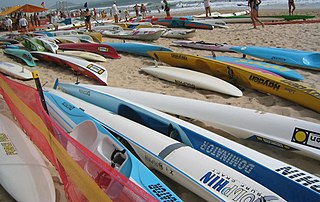
Surf lifesaving is a multifaceted social movement that comprises key aspects of voluntary lifeguard services and competitive surf sport. Originating in early 20th century Australia, the movement has expanded globally to other countries, including New Zealand, Ireland, South Africa, and the United Kingdom. Surf lifesavers in Australia are colloquially known as "Clubbies".

Drowning is a type of suffocation induced by the submersion of the mouth and nose in a liquid. Most instances of fatal drowning occur alone or in situations where others present are either unaware of the victim's situation or unable to offer assistance. After successful resuscitation, drowning victims may experience breathing problems, vomiting, confusion, or unconsciousness. Occasionally, victims may not begin experiencing these symptoms until several hours after they are rescued. An incident of drowning can also cause further complications for victims due to low body temperature, aspiration of vomit, or acute respiratory distress syndrome.
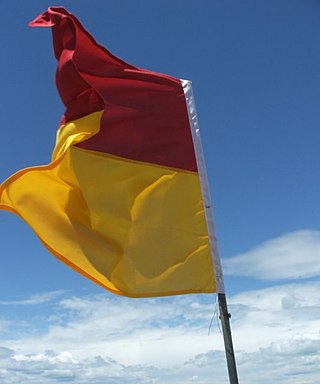
A lifeguard is a rescuer who supervises the safety and rescue of swimmers, surfers, and other water sports participants such as in a swimming pool, water park, beach, spa, river and lake. Lifeguards are trained in swimming and CPR/AED first aid, certified in water rescue using a variety of aids and equipment depending on requirements of their particular venue. In some areas, lifeguards are part of the emergency services system to incidents and in some communities, lifeguards may function as the primary EMS provider.

Rescue swimming is the body of skills that enable an individual to attempt a rescue when a swimmer is in difficulty. These include a combination of communication skills, specific "rescue" swimming strokes, and release and evade techniques for self-preservation should the rescue go wrong.

Diver rescue, usually following an accident, is the process of avoiding or limiting further exposure to diving hazards and bringing a diver to a place of safety. A safe place generally means a place where the diver cannot drown, such as a boat or dry land, where first aid can be administered and from which professional medical treatment can be sought. In the context of surface supplied diving, the place of safety for a diver with a decompression obligation is often the diving bell.
The Royal Life Saving Society UK is a drowning prevention charity founded in 1891 in the UK. It has had Royal Patronage since 1904.

Inflatable Rescue Boats (IRBs) are rubber boats with an outboard motor used in surf lifesaving. IRBs have been used for all forms of surf rescue, retrieval, and service by Surf Lifesaving in New Zealand, Australia, and Del Mar, California since the late 1980s.

Swimming lessons are the process of learning to swim. In most countries there is a definition of a number of swimming levels that are reached in the process of the curriculum. The respective certificates of swimming tests are required for further training in aquatic abilities. Many countries have defined a minimum swimming level that children should reach by the end of primary education, in most cases with the help of school swimming classes being part of the normal curriculum.

The International Life Saving Federation (ILS) is an organisation for drowning prevention, water safety, lifesaving and lifesaving sports.
The Commonwealth Pool Lifesaving Championships is an international event where swimmers from around the Commonwealth take part in lifesaving sport events. The championship is under the auspices of The Royal Lifesaving Society which has Her Majesty Queen Elizabeth II as patron.

Surf Life Saving Australia (SLSA) is an Australian not-for-profit community organisation that promotes water safety and provides surf rescue services.

Lifesaving is the act involving rescue, resuscitation and first aid. It often refers to water safety and aquatic rescue; however, it could include ice rescue, flood and river rescue, swimming pool rescue and other emergency medical services. Lifesaving also refers to sport where lifesavers compete based on skills, technique, speed and teamwork. Lifesaving activities specialized in oceanic environment is called surf lifesaving or coastal lifesaving.
CMAS one-star scuba diver is the entry-level diving certification for recreational scuba diving issued by the Confédération Mondiale des Activités Subaquatiques (CMAS).
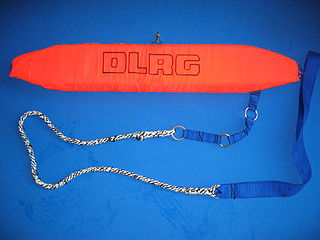
A rescue buoy or rescue tube or torpedo buoy is a piece of lifesaving equipment used in water rescue. This flotation device can help support the victim's and rescuer's weight to make a rescue easier and safer for the rescuer. It is an essential part of the equipment that must be carried by lifeguards. It further can act as a mark of identification, identifying an individual as a lifeguard.
The Bronze Medallion, signifying a qualified lifesaver, has been a lifesaving standard award of The Royal Life Saving Society - Australia and Surf Life Saving Australia for over one hundred years. It was developed in England in 1892. It has evolved over the years to accommodate the environmental conditions of Australia.
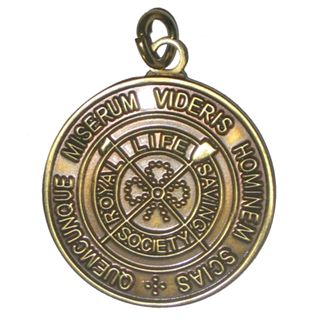
The Bronze Medallion was the flagship award of the Royal Life Saving Society UK until 2012. It was open to those age 14 years of age and over, and consists of resuscitation, theory questions on water safety, self rescue, and rescue principles, and a practical swimming pool based assessment.
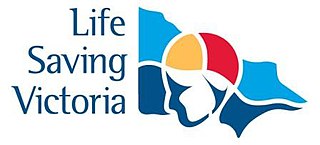
Life Saving Victoria is an Australian life saving organisation formed in 2002 from a merger of the Victorian Branch of the Royal Life Saving Society Australia and Surf Life Saving Victoria. Life Saving Victoria works to prevent drownings and other water related deaths and injuries in Victoria. Life Saving Victoria teaches local communities in Victoria about water safety, swimming and resuscitation. It also provides surf life saving services and patrols for beaches across the state. Life Saving Victoria is an emergency support agency to Victoria Police for water based emergencies.
The South Port Surf Lifesaving Club (SLSC) was established in 1959 in the coastal Adelaide suburb of Port Noarlunga, South Australia, and it is currently situated in the sand dunes at the mouth of the Onkaparinga River Estuary. Due to its location at the mouth of a major South Australian river and its position in Gulf St Vincent, South Port is a renowned surfing beach for both board riders and body surfers.

The Special Malaysian Disaster Assistance and Rescue Team is a disaster relief and rescue task force established under the National Security Council based on the approval of the Cabinet on 18 May 1994. The SMART task force is a United Nations INSARAG certified Heavy USAR in June 2016.